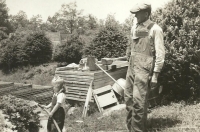
Nancy and Ralph, 1950
Our History
Ralph W. Hershey began growing azaleas in the 1920's and was active in the operation of the business until his death in 1972. His daughter and son, Maereta and Everett Hershey, grew up in the business and remained active until their deaths; Maereta in 1983 and Everett in 2011. The farm is now operated by Everett's daughter, Nancy H. Plumley.
Ralph Hershey's grandfather, J. Williams Thorne, originally owned a farm just east of the Azalea Farm. They were Quakers and active abolitionists. That farm, named Fountain Hill, was a station on the Underground Railroad. After the Civil War, about 1869, Thorne moved his family to Warren County, North Carolina and purchased a run-down plantation. He became involved in politics but about 1886 became tired of the South and returned to Pennsylvania. He bought a piece of woodland adjoining his old farm and erected a small stone house where he died in 1897.
Ralph Hershey, born in 1883, was the son of Thorne's only daughter. He lived with his grandfather from the time he was three years old and after Thorne's death he "hired out" with local farmers. He had a natural mechanical ability and from each farmer he learned new skills and ideas. In 1909 Ralph married Cora Rakestraw from Willowdale, Chester County, and they 'went to housekeeping' in the stone house where he had grown up. When Cora's father gave the couple a milk cow as a wedding present Ralph walked it home from Willowdale, a distance of about 18 miles.
Thorne had planted a small orchard and Ralph expanded this and also added strawberries, blackberries and grapes. He dug out a large root cellar as a place to store the produce until it was sold. In the winter he worked at the Atglen Quarry and became adept in the use of dynamite. Gradually he cleared more ground and blasted out the stumps. Whenever a neighbor had an adjoining woodlot for sale Ralph purchased it and expanded the farm.
Maereta was born in 1910 and Everett in 1912. From the time they were small children they worked alongside their parents in the orchard and berryfields. But Ralph always made time for fun. He used his skills in stone and cement work to construct an above-ground pool. Nearly 25 feet across and 4 feet deep it was a magnet for all the neighorhood kids. Ralph also loved to fish and after he bought a Model T the family would motor down to the Chesapeake. On one of these outings he met Alphonse Perricat, a French immigrant who owned a florist business near Philadelphia. Perricat had purchased a large parcel of land along the bay about seven miles south of North East, Maryland and was selling building lots for 'fishing cabins'.
Ralph bought two lots, but he also accepted the offer of a short-term job delivering Easter flowers for Perricat that spring. When Ralph returned from his stint in Philadelphia he brought with him several azaleas and an idea. He took cuttings and rooted them in flats set on the deep windowsills of the old stone house. Over the next decade he experimented with the best methods for rooting, transplanting and growing and eventually built a glass-roofed greenhouse and shaded rooting house.
By 1940 there were two greenhouses; one heated with coal stoves where the small cuttings spent their first winter and the other, unheated, provided protection from the elements for the two-year-old plants. Each year there were more azaleas and less apples and berries but Ralph never completely gave up growing produce, especially strawberries and blueberries. Everett was drafted during WW II and served in Italy and North Africa as an airplane mechanic. After the war he married and built a house on the farm.
Ralph found it great fun to grow azaleas from seed because every seedling was different in color and growth habit. In the late 1940's a batch of seedlings produced a compact, glossy leaved plant with vibrant red, hose-in-hose flowers. Ralph recognized its potential and introduced it as "Hershey's Red". Within a decade it was the primary red azalea in the trade. Other Hershey introductions over the years include hot pink "Janny" named for Everett's granddaughter and lavender, semi-dwarf "Fountain Hill" which carries the name of Ralph's grandfather's original farm.
In 1955 Ralph planted a one-hundred foot long row of 'Roseum Elegans' Rhododendron to make a windbreak and shade for small azaleas growing beside it. The row has thrived and is now twenty-five feet wide and fifteen feet high. It blooms about the third week of May and is spectacular.
We now use a small tractor instead of a mule to pull our cart and a roto-tiller to work the ground instead of a push-harrow but many things have remained the same. Most growers apply chemical growth regulators to encourage branching but our plants are 'tipped' by hand to shape them. We mow oak leaves in the fall and gather them into a huge pile to use the next spring as a thick mulch on the beds. This helps to keep weeds to a minimum, keeps the soil cool and moist, and breaks down into compost which is then worked back into the soil when the bed is empty. We do not use herbicides and the beds are weeded by hand. The buckets of weeds are dumped over the fence to our two happy goats.